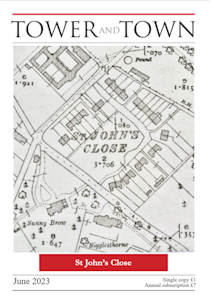

Tower and Town, June 2023 (view the full edition) (view the full edition)The Benefactors
Henry Richardson and Granville Sharp had built fine houses for their retirement - Sigglesthorne and Sunny Brow - situated adjacent to the open land of the Close on Dark Lane (now Hyde Lane). With the Close in view before them, it's not difficult to imagine the seeds of an idea germinating in their minds and the formation of a plan to maximise its potential to change lives for the better. The Close was purchased and between 1908 and 1911. Each financed and oversaw the building of a certain number of houses to make 28 in total, which would be offered at affordable rents to local people. Herbert Leaf (1854-1936) was born in Surrey to Isabella and Charles Leaf, a wealthy silk merchant. He won scholarships to Harrow and Trinity College, Cambridge. As a youth he excelled at sport, representing Cambridge in both cricket and tennis. He taught at Marlborough College from 1877 to 1907. Herbert and Rose were renowned hosts. Lewis Upcott, a colleague, wrote that theirs was 'a perfect union', and that their generosity to neighbours may have been due in part to the loss of their only child. Leaf was exceptionally active in local government and other organisations, including Marlborough Town Council (1899-1912); Savernake Forest Cricket Club (Chairman 1905-29) and Marlborough Town Football Club (President 1905-36). He served as a County Councillor (1899-1930); Lord Mayor of Marlborough (1906-7); Treasurer of the East Wilts Liberal Association, and was appointed Justice of the Peace and Deputy Lieutenant for Wiltshire (both 1912). Throughout his time at Marlborough, he was a generous benefactor to both College and town. As well as his part in the development at St John's Close, other major contributions included a gift to the College of £30,000 in 1920 - which funded the construction of the first electricity plant in Marlborough for lighting to both town and College, as well as a rose garden in memory of his wife who died in 1922. In his will, he left £30,000 to the College which funded a block of classrooms, named after him, and a similarly generous gift of eleven cottages to the town - including those that he owned at St John's Close - and £16,000 which funded the construction of eight dwellings at Leaf Close, Marlborough. Henry Richardson (1845-1914), was born in Reigate, Surrey, and was the second son of Amelia and George Richardson, a hops merchant. Following graduation from Corpus Christi College, Oxford, he came to teach at Marlborough College in 1870, subsequently being appointed Master of the Lower School (1873-79), Housemaster of B2 (1872-73) and of Littlefield (1886-1905), and President of the Marlborough College Natural History Society (1880-86). Within the College he was universally liked and respected. He famously introduced the game of hockey in 1874 as an alternative to athletics during colder months, with practice taking place amongst the tufts and tussocks on the Common. Granville Sharp (1849-1931) was the youngest son of Emma and William Sharp, a surgeon, and was educated at Rugby and Lincoln College, Oxford. He came to teach at Marlborough College 1873, and was later appointed Housemaster of C3 (1875-83), Librarian (1886-93), and President of Common Room. He was the author of Exercises in French Syntax, with Rules (1884) and Birds in the Garden: Studies with a Camera (1902), which was illustrated with photographs taken in his garden at Sunny Brow (now Hyde Cross). He is remembered as a quiet, thoughtful and kind-hearted man who was reserved and somewhat reclusive. As College Librarian, he earned repute as 'the daring innovator who introduced the Novel'. He retired early to care for his mother. Gráinne Lenehan |